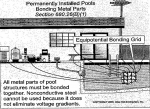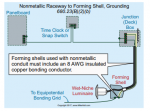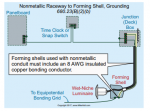wlnorris
Member
- Location
- Flemingsburg, Kentucky
- Occupation
- Electrical Engineer
This is more of an engineering question about what NEC describes. So if you look at a cutaway diagram of what they describe, you have a lug, which on the inside, gets this #8 bonding jumper, and on the outside, your pool bond connects to it. Then you run this bonding jumper back up to your lighting junction box. There, it connects to the aluminum bar where your equipment grounds connect.
So it is a jumper between bonding loop and equipment ground.
So you are connecting your bonding loop for the entire pool, to your equipment ground; for the light circuit at least, but ultimately to all your equipment grounds, because they all probably tie to the same bar back in your panel somewhere.
But what if someone took their bonding loop, which also connects to a bonding loop lug on your lighting junction box, and then from there, put in a short jumper to the equipment ground bar?
What is the different in protection between those two methods? I'm having trouble visualizing a difference. Both are your entire bonding loop getting connected to equipment ground, in the same place.
The only obvious difference I see is the jumper in a conduit is less likely to be cut by digging or drilling, since it is in conduit. Maybe less likely to be disconnected since one end is underwater behind a light.
So I see some mechanical reasons for this, but would there be an actual difference in electrical protection, in a correctly connected, undamaged system?
So it is a jumper between bonding loop and equipment ground.
So you are connecting your bonding loop for the entire pool, to your equipment ground; for the light circuit at least, but ultimately to all your equipment grounds, because they all probably tie to the same bar back in your panel somewhere.
But what if someone took their bonding loop, which also connects to a bonding loop lug on your lighting junction box, and then from there, put in a short jumper to the equipment ground bar?
What is the different in protection between those two methods? I'm having trouble visualizing a difference. Both are your entire bonding loop getting connected to equipment ground, in the same place.
The only obvious difference I see is the jumper in a conduit is less likely to be cut by digging or drilling, since it is in conduit. Maybe less likely to be disconnected since one end is underwater behind a light.
So I see some mechanical reasons for this, but would there be an actual difference in electrical protection, in a correctly connected, undamaged system?




